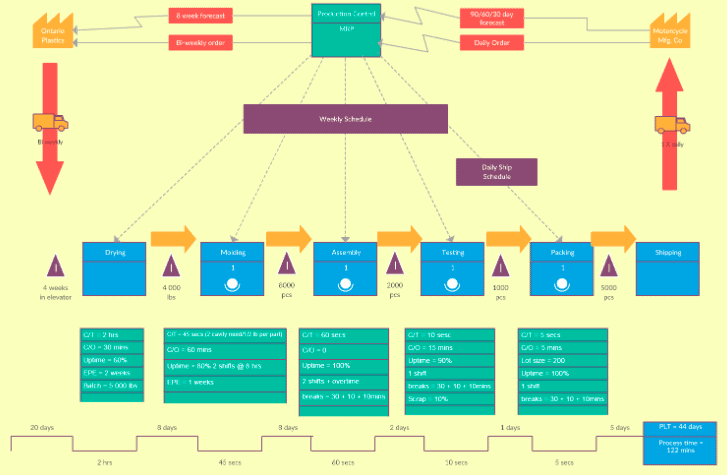A value stream map is a method of visualizing all steps needed to transform a customer request into a product or a service.
Value stream mapping has been growing in popularity since the 90’s and became a fundamental tool to use when implementing Lean or Lean Six Sigma in any type of industry.

Even though the term “value stream” was first coined in early 90’s by James P. Womack and Daniel T. Jones, in their books “Lean Thinking” and “The Machine that Changed the World”, the concept can be traced back to Toyota and their approach of mapping the material and information flow within the organization. This particular mapping technique became more and more popular as companies worldwide observed and studied the efficiency and consistency of Toyota’s operations. Toyota’s mapping methodology was also described in late 90’s by John Shook (LEI CEO) and Mike Rother (U of Michigan) in their book “Learning to See”.
Value stream mapping (VSM) helps you see all the steps in your process, both value added and wasteful steps, with the final goal of improving efficiency and value. It helps pinpoint non-value added steps that should be eliminated to achieve better and faster outcomes. By visualizing all steps in the process, you can identify, remove or reduce the waste in any particular value stream. The flowchart shows both the materials and information as they advance through the process; therefore it is also called “material and information flow mapping”.
Waste is defined as any activity that does not add value to the final product or service. When creating a value stream map, it is important to keep in mind that customers (external or internal) always care about the value of the product or service and not the efforts made to produce it. VSM relies on standard symbols across industries that make maps readable by anyone, even when they are not familiar with the process in question.
There are two types of value stream maps: current state map and future state map. The first step of value stream mapping is to create a current state map. Drawing a current state map requires gathering information on the product or service full path. Therefore, you will need to “walk down the path” the product or service takes as it travels through; from the point you received the customer’s request to the point it is delivered to the customer.
The current state value stream map is used to determine what the process currently looks like and helps you visualize waste, as any kind of inefficiencies, overproduction, downtime, excess inventories, delays, bottlenecks and such. The future state value stream map focuses on what the process should look like after process improvements have been implemented and waste has been reduced or eliminated.
Originated in manufacturing, value stream mapping can and has been applied to various industries and fields like service, healthcare, government, logistics, as well as to new product development. Check this Lean Enterprise Institute video on applying value stream mapping to product development.
